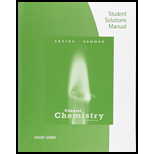
The amount of sodium hypochlorite in a bleach solution can be determined by using a given volume of bleach to oxidize excess iodide ion to iodine, because the reaction goes to completion. The amount of iodine produced is then determined by titration with sodium thiosulfate, Na2S2O3, which is oxidized to sodium tetrathionate, Na2S4O6. Potassium iodide was added in excess to 5.00 mL of bleach (density = 1.00 g/mL). This solution, containing the iodine released in the reaction, was titrated with 0.100 M Na2S2O3. If 34.6 mL of sodium thiosulfate was required to reach the endpoint (detected by disappearance of the blue color of the starch iodine complex), what was the mass percentage of NaClO in the bleach?
Want to see the full answer?
Check out a sample textbook solution
Chapter 21 Solutions
Student Solutions Manual for Ebbing/Gammon's General Chemistry, 11th
- Aluminum is produced commercially by the electrolysis of Al2O3 in the presence of a molten salt. If a plant has a continuous capacity of 1.00 million A, what mass of aluminum can be produced in 2.00 h?arrow_forwardThree reactions very important to the semiconductor industry are The reduction of silicon dioxide to crude silicon, SiO2(s) + 2 C(s) → Si(s) + 2 CO(g) ΔrH° = 689.9 kJ/mol The formation of silicon tetrachloride from crude silicon, Si(s) + 2 Cl2(g) → SiCl4(g) ΔrH° = −657.01 kJ/mol The reduction of silicon tetrachloride to pure silicon with magnesium, SiCl4(g) + 2 Mg(s) → 2 MgCl2(s) + Si(s) ΔrH° = −625.6 kJ/mol Calculate the overall enthalpy change when 1.00 mol sand, SiO2, changes into very pure silicon by this series of reactions.arrow_forward4.48 Elemental phosphorous is used in the semiconductor industry. It can be obtained from an ore called fluoroapatite via reaction with SiO2 and C: 4Ca5( PO4)3F+18SiO2+30C3P4+30CO+18CaSiO3+2CaF2 Suppose a particular semiconductor production plant requires 1500 kg of P4. If the recovery of P4 from this reaction is 73% efficient, what mass of fluoroapatite is needed?arrow_forward
- Write balanced net ionic equations for the following reactions in acid solution. (a) Liquid hydrazine reacts with an aqueous solution of sodium bromate. Nitrogen gas and bromide ions are formed. (b) Solid phosphorus (P4) reacts with an aqueous solution of nitrate to form nitrogen oxide gas and dihydrogen phosphate (H2PO4-) ions. (c) Aqueous solutions of potassium sulfite and potassium permanganate react. Sulfate and manganese(II) ions are formed.arrow_forwardPhosphorus occurs naturally in the form of fluorapatite, CaF2 3Ca3(PO4)2. The dot indicates 1 part CaF2 to 3 parts Ca3(PO4)2. This mineral is reacted with an aqueous solution of H2SO4 in the preparation of a fertilizer. The products are phosphoric acid, hydrogen fluoride, and gypsum, CaSO4 2H2O. Write the balanced equation describing this process.arrow_forward(a) Write equations for the half-reactions that occur at the cathode and the anode when an aqueous solution of KCl is electrolyzed. Which chemical species is oxidized, and which chemical species is reduced in this reaction? (b) Predict the products formed when an aqueous solution of CsI is electrolyzed.arrow_forward
- The reaction of elemental phosphorus and excess oxygen produces P4O10. Name the compound. (a) phosphorus oxide (b) phosphoric acid (c) phosphorus decaoxide (d) tetraphosphorus decaoxidearrow_forwardComplete and balance the equations of the following reactions, each of which could be used to remove hydrogen sulfide from natural gas: (a) Ca(OH)2(s)+H2S(g) (b) Na2CO3(aq)+H2S(g)arrow_forwardIn acidic solution, sodium oxalate, Na₂C₂O4, is oxidized to CO₂ by MnO4. In the process, MnO, is reduced to Mn² +. To titrate a 0.855 g sample of Na₂C₂O₁, 43.7 mL of an MnO solution were required. The same MnO solution is then used to analyze samples that contain uranium. A 12.8 g sample of a material that contains uranium required 29.3 mL of the MnO, solution for titration. During titration, the uranium sample was oxidized as shown. UO² (aq) → UO *(aq) Calculate the mass percent of uranium in the sample. mass percent of uranium: %arrow_forward
- Write the balanced net ionic equation for the reaction of hydrogen sulfide (H2S) with bromate ions, BrO3-, in acidic solution to form sulfur ions and bromide ions. How many H+ are there in the balanced equation?arrow_forwardLaundry bleach such as Clorox is a dilute solution of sodium hypochlorite, NaOCI. Write a balanced net ionic equation for the reaction of NaOCI with Na2S₂O3. The OCI-is reduced to chloride ion and the S₂O3²- is oxidized to sulfate ion. Don't include physical states for your answer.arrow_forwardOne way to determine the concentration of hypochlorite ions (ClO–) in solution is by first reacting them with I– ions. Under acidic conditions the products of this reaction are I2 and Cl– ions. Then the I2 produced in the first reaction is titrated with a solution of thiosulfate ions (S2O32–). The products of the titration reaction are S4O62– and I– ions.arrow_forward
 Chemistry: Principles and ReactionsChemistryISBN:9781305079373Author:William L. Masterton, Cecile N. HurleyPublisher:Cengage Learning
Chemistry: Principles and ReactionsChemistryISBN:9781305079373Author:William L. Masterton, Cecile N. HurleyPublisher:Cengage Learning General Chemistry - Standalone book (MindTap Cour...ChemistryISBN:9781305580343Author:Steven D. Gammon, Ebbing, Darrell Ebbing, Steven D., Darrell; Gammon, Darrell Ebbing; Steven D. Gammon, Darrell D.; Gammon, Ebbing; Steven D. Gammon; DarrellPublisher:Cengage Learning
General Chemistry - Standalone book (MindTap Cour...ChemistryISBN:9781305580343Author:Steven D. Gammon, Ebbing, Darrell Ebbing, Steven D., Darrell; Gammon, Darrell Ebbing; Steven D. Gammon, Darrell D.; Gammon, Ebbing; Steven D. Gammon; DarrellPublisher:Cengage Learning Chemistry: The Molecular ScienceChemistryISBN:9781285199047Author:John W. Moore, Conrad L. StanitskiPublisher:Cengage Learning
Chemistry: The Molecular ScienceChemistryISBN:9781285199047Author:John W. Moore, Conrad L. StanitskiPublisher:Cengage Learning Chemistry & Chemical ReactivityChemistryISBN:9781337399074Author:John C. Kotz, Paul M. Treichel, John Townsend, David TreichelPublisher:Cengage Learning
Chemistry & Chemical ReactivityChemistryISBN:9781337399074Author:John C. Kotz, Paul M. Treichel, John Townsend, David TreichelPublisher:Cengage Learning Chemistry & Chemical ReactivityChemistryISBN:9781133949640Author:John C. Kotz, Paul M. Treichel, John Townsend, David TreichelPublisher:Cengage Learning
Chemistry & Chemical ReactivityChemistryISBN:9781133949640Author:John C. Kotz, Paul M. Treichel, John Townsend, David TreichelPublisher:Cengage Learning ChemistryChemistryISBN:9781305957404Author:Steven S. Zumdahl, Susan A. Zumdahl, Donald J. DeCostePublisher:Cengage Learning
ChemistryChemistryISBN:9781305957404Author:Steven S. Zumdahl, Susan A. Zumdahl, Donald J. DeCostePublisher:Cengage Learning





